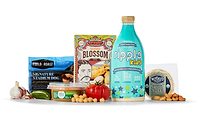The number of Americans who consider healthfulness when purchasing their food and beverages has shown a significant uptick in the past two years, according to the Washington, D.C.-based International Food Information Council (IFIC) Foundation’s 2014 Food and Health Survey. The survey also evaluated the “emotional” conversations consumers have about food, finding that fewer than one in four have these conversations.
Healthfulness
While taste and price consistently have been the Top 2 factors that impact consumers’ food and beverage purchases at 90 percent and 73 percent, respectively, healthfulness in 2014 almost entirely closed the gap with price, rising from 61 percent of consumers in 2012 to 71 percent this year, the survey reports.
Beneath the surface, certain subpopulations saw greater relative increases than others. Consumers between the ages of 18 and 34 who cited healthfulness as a driver of food and beverage purchases increased from 55 percent in 2013 to 66 percent in 2014, significantly narrowing the gap with other age groups. In addition, this opinion increased among men to 65 percent from 56 percent last year, and among college graduates to 67 percent from 61 percent last year.
As in previous years, consumers reported other areas where they are trying to improve the healthfulness of their diets. More than four out of five consumers reported that they’ve tried to eat more fruits and vegetables either within the past year or for more than a year; 79 percent said they have cut calories by drinking water or low- and no-calorie beverages; and 72 percent said they are eating more whole grains. In addition, 54 percent reported that they are trying to lose weight while 25 percent cited they are trying to maintain their current weight.
When consumers rated their priorities in life, the importance of a healthful diet often ranked either the same as or more important than other major priorities, the survey found. Other priorities rated as “about the same as” or “less important than” than a healthful diet included spending time with loved ones, minimizing stress, having a healthy financial situation, getting enough exercise, feeling fulfilled in their jobs, and having an active social life.
“While people’s attitudes about healthfulness in their food and beverage purchases and consumption alone don’t necessarily mean we are a healthier country today than we were a year or two ago, it could signal that we are moving in the right direction,” said Marianne Smith Edge, senior vice president of nutrition and food safety at the IFIC Foundation, in a statement. “If perceptions translate into actions, the impact on the health and wellness of our nation could be significant and long-lasting.”
Emotional conversations
Public dialogue reviews conducted by the IFIC Foundation independent of the Food and Health Survey suggest growing intensity both online and in traditional media in conversations about food and the food production system, particularly among those with negative perceptions.
However, given that only 23 percent of survey respondents reported having had an “emotional conversation” about food in the past six months, it is possible that those who are dominating the discussions and perpetuating negativity about food are a distinct minority.
Fifty percent of respondents reported having conversations about food that are not emotional.
“While it is a classic example of the most sensational and entertaining reports getting attention, our data show the vast majority of consumers are not swayed by the rhetoric,” said David B. Schmidt, president and chief executive officer of the IFIC Foundation, in a statement. “Most consumers are making health a conscious decision and trust those experts and organizations with the most authoritative training and expertise.”
Additional findings
Confidence in food safety: While a solid majority remain confident in the safety of the U.S. food supply, this has steadily eroded since 2012. This year, 66 percent of consumers said they are at least somewhat confident in the food supply, while 30 percent are not too confident or not at all confident, compared with 78 percent and 17 percent, respectively, in 2012, representing an overall negative swing of 24 points.
When it comes to information about food safety, food ingredients, and the way foods and beverages are farmed and produced, government agencies are consumers’ go-to source, chosen as most trusted by 39 percent, 26 percent and 28 percent, respectively. Social media and TV personalities were considered the most-trusted resource for all three information categories by only 2 percent or fewer consumers. The news media rated 5 percent, 3 percent and 12 percent, respectively.
Planning what we eat: When it comes to what consumers use on a regular basis to help plan what they consume, shopping lists ranked the highest at 59 percent, followed by coupons at 53 percent, in-store discounts at 49 percent, recipes at 45 percent, and meal plans at 24 percent.
Checking the label: Between 2013 and 2014, decreases were found in the categories of information consumers say they look for on food and beverage labels. “Expiration date” still leads the list at 66 percent, returning to traditional levels after a spike last year to 82 percent. The percentage of consumers who check the Nutrition Facts panel was relatively unchanged this year at 65 percent, along with the ingredients list at 52 percent and calorie/nutrition information at 42 percent.
Significant decreases in label-reading behavior were found with serving sizes and amount per container at 44 percent in 2014 vs. 55 percent in 2013, brand name at 35 percent in 2014 vs. 53 percent in 2013, cooking instructions at 32 percent vs. 45 percent, and statements about nutrition benefits at 30 percent vs. 43 percent.
Consumption of nutrients and food components: The survey also revealed the nutrients or food components consumers are trying to either increase or limit consumption. Fifty-three percent of consumers reported that they are trying to consume a certain amount of or as much as possible fiber and whole grains, with protein following at 50 percent, calcium at 36 percent, omega-3s at 21 percent, potassium at 19 percent, and probiotics at 18 percent.
Conversely, consumers reported either trying to limit or avoid entirely sodium (53 percent), sugars (50 percent), calories (48 percent), fats and oils (29 percent), caffeine (31 percent), and mono/polyunsaturated fats (26 percent).
Dining out: About half of all consumers report (51 percent) using nutrition information such as calorie counts when dining at restaurants; however, 23 percent have noticed such information but don’t pay attention to it, and 26 percent haven’t noticed such information at all.
Sugars in our diets: Although still a majority, significant declines were seen among respondents who believe moderate amounts of sugar can be part of an overall healthful diet and those who believe people with diabetes can include some foods with sugar as part of their total diet. Half of consumers (51 percent) reported that they are getting “pretty close to” or less than what they believe is the appropriate amount of sugars in their diets.
Caffeine: Three out of five consumers (60 percent) agreed at least somewhat that they know the amount of caffeine in the foods and beverages they consume. On the other hand, when asked whether they believe an 8-ounce cup of home-brewed coffee has roughly the same amount of caffeine as an 8-ounce energy drink, only 18 percent correctly answered “True,” while 45 percent answered “False.”
Sustainability: During the past year, 62 percent of respondents said they have given at least a little thought to the environmental sustainability of their foods and beverages, with 35 percent giving it no thought. That’s down slightly from both 2012 and 2013 when 66 percent gave sustainability at least a little thought and 30 percent gave it no thought.
“Natural,” “organic” and “local”: More than a third of consumers report regularly buying food that is labeled as “natural” (37 percent) or “local” (35 percent), with 32 percent regularly buying products labeled as “organic.”
The 2014 Food and Health Survey was fielded by Greenwald & Associates of Washington, D.C., between March 26 and April 7 and involved 1,005 Americans between the ages of 18 and 80. Results were weighted to match the U.S. Census based on age, education, gender, race and ethnicity, and region to be nationally reflective.



